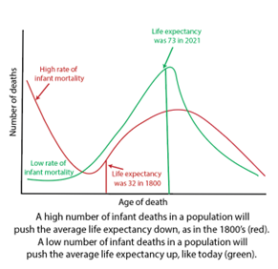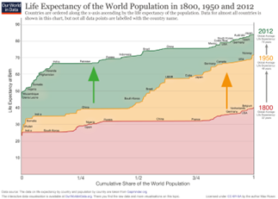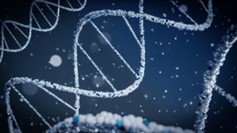Age is more than just a number: The determinants for aging
How High Can you Go: the Human Lifespan
Author: Bethany Dodds
The concept of immortality has been something that has fascinated humans for thousands of years, taking its roots in early religions with the promise of the afterlife and reincarnation. In this time, humans have embarked on a quest to restore youth and extend lifespans, promised in myths such as the philosophers stone and the fountain of youth. And yet, thousands of years later, the concept of immortality and everlasting youth is still only bound to legend… or is it? Over the past 200 years, however, life expectancy has increased dramatically. New research from an international collaboration of over 40 scientists concluded that the reason for this is due to a reduction in infant mortality, which bring the lifespan from 32 to 73. The scientists argue that we probably cannot slow the rate at which we age due to various biological constraints. However, this theory is heavily contested, with some scientists believing we can slow the rate of ageing and extend the human lifespan with advancements in modern medicine. As medicine carries on developing and we begin to understand biological constraints better, could we live forever, or will immortality only ever exist within stories?
Biological constraints limit how old we can become
Human life expectancy has been growing steadily for the past 200 years, from an average age of 32 in 1800 to an age of 73 in 2021, as determined by the World Health Organisation (WHO). An international collaboration of over 40 scientists aimed to determine the factors for the increase in average life expectancy, and questioned whether we can slow the rate of ageing in humans. And what they discovered might surprise you: the single biggest reason we our life expectancies have changed is due to the reduction in infant mortality. By considering the life expectancy of only those that reach adulthood, life expectancy is actually not so different now than it was 200 years ago. Thus the scientists concluded that their research supports what is known as the invariant rate of ageing hypothesis. Sounds complicated I know, but what it means is that the age of humans cannot be extended further, and that certain biological constraints determine our aging process and how long we live. Currently, it appears that the upper ceiling for the human lifespan is around 120 years old: the oldest documented person to ever live is Jeanne Calment, who made it to the age of 122 years and 164 days. Thus, in context to the invariant rate of ageing hypothesis, it would seem very unlikely that anyone could make it past this age.

The future of ageing
However, not all scientists agree with the invariant rate of ageing hypothesis, and some think that we can push past the 120 year ago limit. Future advancements in areas such as tissue engineering and nanomedicine may allow us to push past this upper ceiling, some even arguing we could change the average life expectancy to over 5,000 years.

Global life expectancy has been increasing steadily since the 1800’s, due to a reduction in infant mortality. Image source: Our World in Data
The biochemical processes that keep us alive are also what ages us and inevitably leads to our death (seems counter-intuitive, right). Let’s think of oxygen for example. We all need oxygen to live, but in our cells this produces oxidising effects (this is the opposite of an anti-oxidant). These processes generate toxins, which cause cellular damage and lead to senescence (in simple terms: the aging of cells). As we begin to understand these processes better, can we tap into the biological mechanisms of our cells to prevent aging? The invariant rate of ageing hypothesis would argue no, but there are several strategies in development that tap into these mechanisms. For example, a vaccine strategy has been recently developed, that has been shown to kill senescent (i.e. ageing) cells in mice, improving their lifespan and slowing down aging. Check out our article here (link to Evas article) for more information. Another technique to extend the human lifespan would be with the generation of atomically precise engineering. In other words, building molecular structures atom by atom using nanorobots. These nanorobots thus have the potential to remove toxins, repair neurons and DNA damage and destroy cancer cells, to name a few.
Robert Freitas Jr, member of the Nanofactory collaboration and co-author of the book, The Future of Aging, Pathways to Human Life Extension, believes that the development of these medical nanorobots are ‘virtually inevitable’ so long as this collaboration continues to receive funding. However, according to Freitas, we can still be expecting to wait several decades before this technology becomes available for human use. And even then, questions of morality and ethics still need to be discussed.

Repairing cellular and DNA damage could be the way to go to achieve immortality. Image source: usplash.com
Well, what can we do now then?
So, it seems like right now, so long as we make it past childhood and live healthy and happy lives there is not so much that we can do to extend our lifespan. Medical innovations to extend lifespan seem to be far in the distance, and so for now we can assume that the invariant rate of ageing hypothesis is true. Of course, don’t let this hypothesis excuse you from living an unhealthy lifestyle, because this will reduce you own life expectancy. Rather what the research determines is that after a certain level of living a healthy lifestyle, you cannot reasonably expect to live longer. So, my advice would be to live life to the fullest, eat your vegetables and breathe in the fresh air; don’t wait around for medicine to make you live longer.
(Call to Action)
What do you think? Do you think it would be a good thing to extend the human lifespan even further, or do you think the upper ceiling is 120 years for a reason? Let us know in the comments!
Sources (How High Can you Go: the Human Lifespan)
Bhardwaj, R., Amiri, S., Buchwald, D., & Amram, O. (2020). Environmental Correlates of Reaching a Centenarian Age: Analysis of 144,665 Deaths in Washington State for 2011-2015. International Journal of Environmental Research and Public Health, 17(8). https://doi.org/10.3390/IJERPH17082828
Colchero, F., Aburto, J. M., Archie, E. A., Boesch, C., Breuer, T., Campos, F. A., Collins, A., Conde, D. A., Cords, M., Crockford, C., Thompson, M. E., Fedigan, L. M., Fichtel, C., Groenenberg, M., Hobaiter, C., Kappeler, P. M., Lawler, R. R., Lewis, R. J., Machanda, Z. P., … Alberts, S. C. (2021). The long lives of primates and the ‘invariant rate of ageing’ hypothesis. Nature Communications 2021 12:1, 12(1), 1–10. https://doi.org/10.1038/s41467-021-23894-3
Fahy, Gregory & West, Michael & Coles, L. & Harris, Steven. (2010). The Future of Aging: Pathways to Human Life Extension. 10.1007/978-90-481-3999-6.
Life Expectancy – Our World in Data. (n.d.). Retrieved April 7, 2022, from https://ourworldindata.org/life-expectancy
Life expectancy at birth (years). (n.d.). Retrieved April 7, 2022, from https://www.who.int/data/gho/data/indicators/indicator-details/GHO/life-expectancy-at-birth-(years)
Readers reply: how long could a person possibly live? | Ageing | The Guardian. (n.d.). Retrieved April 7, 2022, from https://www.theguardian.com/science/2022/mar/13/readers-reply-how-long-could-a-person-possibly-live
Suda, M., Shimizu, I., Katsuumi, G., Yoshida, Y., Hayashi, Y., Ikegami, R., Matsumoto, N., Yoshida, Y., Mikawa, R., Katayama, A., Wada, J., Seki, M., Suzuki, Y., Iwama, A., Nakagami, H., Nagasawa, A., Morishita, R., Sugimoto, M., Okuda, S., … Minamino, T. (2021). Senolytic vaccination improves normal and pathological age-related phenotypes and increases lifespan in progeroid mice. Nature Aging 2021 1:12, 1(12), 1117–1126. https://doi.org/10.1038/s43587-021-00151-2

